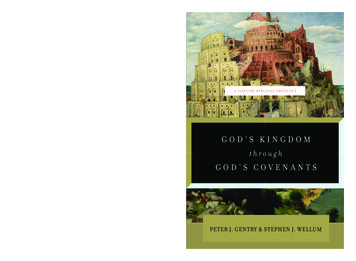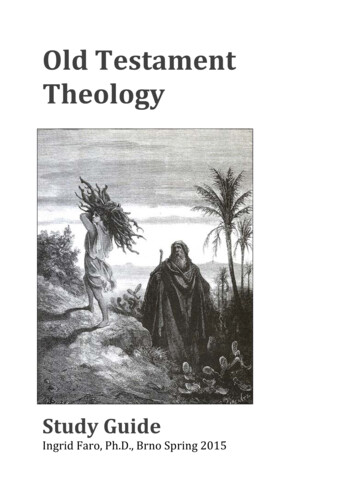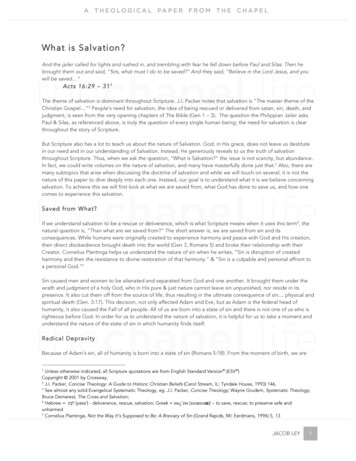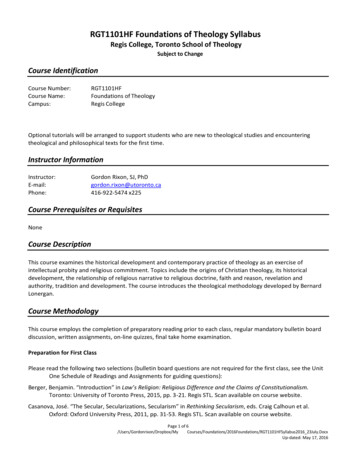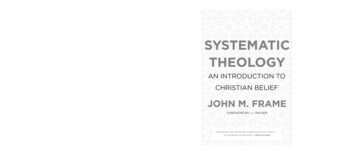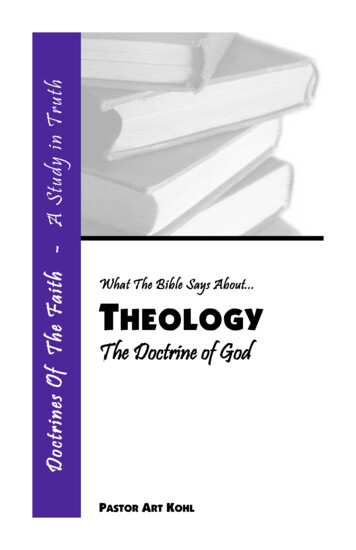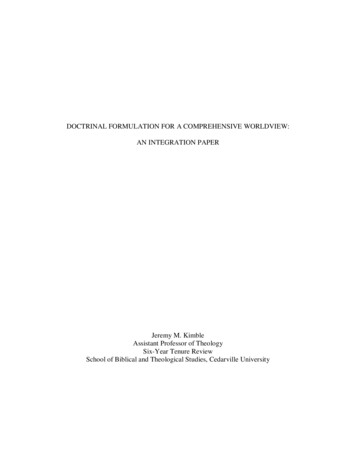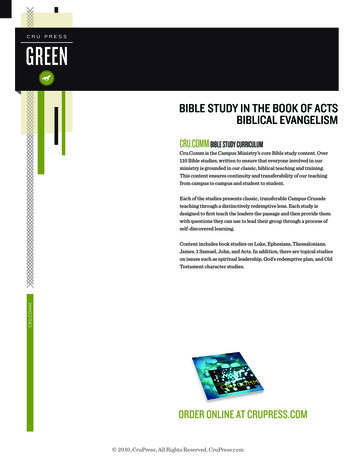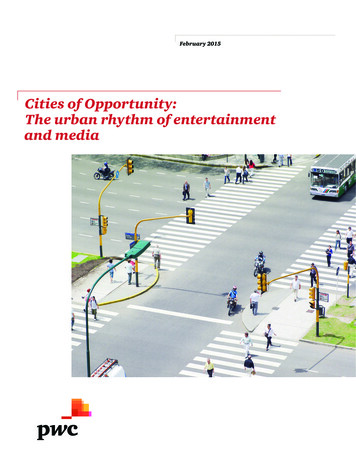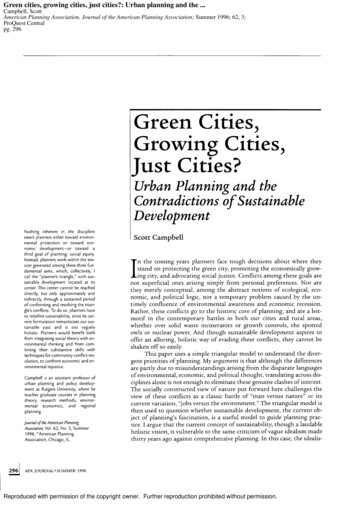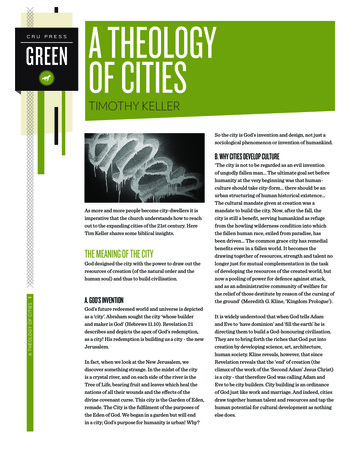
Transcription
A THEOLOGYOF CITIESTIMOTHY KELLERSo the city is God’s invention and design, not just asociological phenomenon or invention of humankind.B. WHY CITIES DEVELOP CULTUREAs more and more people become city-dwellers it isimperative that the church understands how to reachout to the expanding cities of the 21st century. HereTim Keller shares some biblical insights.THE MEANING OF THE CITYA TH EO LO GY O F CI TI E S1God designed the city with the power to draw out theresources of creation (of the natural order and thehuman soul) and thus to build civilisation.A. GOD’S INVENTIONGod’s future redeemed world and universe is depictedas a ‘city’. Abraham sought the city ‘whose builderand maker is God’ (Hebrews 11.10). Revelation 21describes and depicts the apex of God’s redemption,as a city! His redemption is building us a city - the newJerusalem.In fact, when we look at the New Jerusalem, wediscover something strange. In the midst of the cityis a crystal river, and on each side of the river is theTree of Life, bearing fruit and leaves which heal thenations of all their wounds and the effects of thedivine covenant curse. This city is the Garden of Eden,remade. The City is the fulfilment of the purposes ofthe Eden of God. We began in a garden but will endin a city; God’s purpose for humanity is urban! Why?‘The city is not to be regarded as an evil inventionof ungodly fallen man. The ultimate goal set beforehumanity at the very beginning was that humanculture should take city-form. there should be anurban structuring of human historical existence.The cultural mandate given at creation was amandate to build the city. Now, after the fall, thecity is still a benefit, serving humankind as refugefrom the howling wilderness condition into whichthe fallen human race, exiled from paradise, hasbeen driven. The common grace city has remedialbenefits even in a fallen world. It becomes thedrawing together of resources, strength and talent nolonger just for mutual complementation in the taskof developing the resources of the created world, butnow a pooling of power for defence against attack,and as an administrative community of welfare forthe relief of those destitute by reason of the cursing ofthe ground’ (Meredith G. Kline, ‘Kingdom Prologue’).It is widely understood that when God tells Adamand Eve to ‘have dominion’ and ‘fill the earth’ he isdirecting them to build a God-honouring civilisation.They are to bring forth the riches that God put intocreation by developing science, art, architecture,human society. Kline reveals, however, that sinceRevelation reveals that the ‘end’ of creation (theclimax of the work of the ‘Second Adam’ Jesus Christ)is a city - that therefore God was calling Adam andEve to be city builders. City building is an ordinanceof God just like work and marriage. And indeed, citiesdraw together human talent and resources and tap thehuman potential for cultural development as nothingelse does.
There is no absolute way to define a ‘city’. A humansettlement becomes more ‘urban’ as it becomes morea) dense and b) diverse in its population. God madethe city to be a developmental tool, a form of cultural‘gardening’, designed to draw out the riches he putinto the earth, nature and the human soul at creation.Even after the fall, cities are places of ‘common grace’though each factor also now can be used (and is!) forevil purposes.Practical note: The city, then, has a powerfulmagnifying glass effect. Since God invented it as a‘cultural mine’, it brings out whatever is in the humanheart. Why? The density and therefore diversity ofthe city brings out the best (and the worst - see below)in the human heart. How does it do so? The divinelygiven ability of the city to do ‘culture-making’ canbe discerned at the most practical level by the urbanresident.C. HOW IT DOES IT* The city puts me together with unique numbers ofpeople unlike me.A T HEO LO GY O F CIT IES21. First, the city (as the Garden) is a place of refuge andsafety. It has always been a place where people comewho are too weak to live in other places. In the earliestdays, cities provided refuge from wild animals andmarauding tribes and criminals. When Israel movedinto the promised land, the first cities were built byGod’s direction as ‘cities of refuge’, where the accusedperson could flee for safety and civil justice. ThusGod invented cities to be a sign of divine, not self,protection. Even today, people like the homeless, ornew immigrants, or the poor, or people with ‘deviant’lifestyles, must live in the city. The city is always amore merciful place for minorities of all kinds. Why?The density of the city creates the possibility of strongminority communities. Density creates diversity. Thedominant majorities often dislike cities, but the weakand powerless need them. They cannot survive in thesuburbs and small towns. Cain built his cities for selfprotection from God and the vengeance of others. Sothe refuge of the city can be misused, as when peoplewith sinful lifestyles find refuge in the city from thedisapproval of the broader culture.Practical note: It is hard for middle-class families tolive in the cities, and thus the cities are seen as hostileplaces. But for anyone who is not part of the dominantculture (singles, the poor, ethnic minorities, etc.) thecity has great advantages over non-urban areas.2. Second, the city as a cultural mining/developmentcentre. Even the description of the wicked city ofBabylon shows the power of the city to draw out theresources of creation - of the physical world and thehuman soul. In Revelation 18 we see that the city isa place of 1) music and the arts (v.22a), 2) crafts andworks of all arts and manufacturing (v.22b), 3) tradeand retailing (v.23c), 4) technological advance (v.23a),5) family building (v.23b). This is what the city wasdesigned by God to do, as an instrument of glorifyinghim by ‘mining’ the riches of creation and building aGod-honouring civilisation.* The city attracts the minorities of any society whocan band together for mutual support. Thus the city isdeeply merciful to those with less power, creating safeenclaves for singles vs. families, the poor (and eventhe rich!) vs. the bourgeois, immigrants vs. longerterm residents, racial minorities vs. majorities. Thusthe city will always be the most diverse human-lifestructure.* Because I am put together (by its density) withunique numbers of diverse people, all my thinkingand views are radically challenged. I am confrontedwith creative new ways to think about things, andI must abandon my traditional ways or become farmore knowledgeable and committed to them thanI was before. Thus I become vastly more creative,committed, skilful in all I am or do.* Sin takes this divine-strength - the diversity of thecity - and turns it into a place of conflict and strife.The gospel is needed to resist the dark side of this gift.* The city puts me together with unique numbers ofpeople like me.* The city also attracts the strongest as well as theweakest (see above). The challenge of the city attractsthe most talented, ambitious (and restless, see below).Thus, whoever you are, when you come to the city youare confronted by far more people who are far betterthan you at whatever you do.* Because I am put together with unique numbers oflike-but-extremely-skilled people in my field, I amradically challenged to ‘reach down deep’ and do myvery best. More than that, I feel driven and pressed bythe intensity of the density to realise every ounce ofmy potential.* Sin takes this divine strength - the culture-forming
intensity - and turns it into a place (also) of bothdeadly hubris and burn-out. The gospel is needed toresist the dark side of this gift.Cities draw and gather together human resourcesand tap their potential for cultural development as noother human-life organisation structure can.It is quite wrong to see the city as intrinsically evil! Itwas designed by God to ‘draw out’ and to ‘mine’ whatGod made. We should appreciate the power of the cityand realise that the tremendous evil has been broughtto it by us!A THEO LO GY O F CIT I ES33. Third, the city as the place to meet God. Ancientcities were religious institutions. They were usuallybuilt around a ‘ziggurat’ - the original skyscrapers!They were temples where a particular god wasthought to ‘come down’. The cities were seen to be theroyal residences of the god, and the city was dedicatedto him/her. The city was where the cultus for thatgod was centred, and where you went if you wantedto serve him or her. All of this was probably a twisted‘memory trace’ of the original design of God, that theEdenic city, the new Jerusalem, would be the placewhere people would meet him, where his temple/presence would be.After Eden was lost to us (temporarily) through sin,God creates a new city in the desert, by dwellingamong his people in the tabernacle, and around hisTent is a city of tents. The city of God will be hisdwelling place. Later, the earthly city of Jerusalembecomes a symbol and sign to the future city of God.In the earthly Jerusalem, God’s dwelling place, thetemple, stands as the central integrating point of thecity’s architecture and as apex of its art and scienceand technology. As a result, Jerusalem is ‘the joy of thewhole earth’ (Psalm 48.2). But she is only a sign of thecity of God which is heavenly and which is to come.All true believers even now have as their mother, ‘theJerusalem that is above, is free’ (Galatians 4.26).Why are cities always ‘religious hotbeds’ where peopleare spiritually seeking and restless? The density anddiversity of the city - the same dynamics that producecultural development - also keep people spiritually‘off balance’ and restless. Cities, therefore, are the keyto evangelism in any area. Paul’s missionary journeysessentially ignored the countryside. When he entereda new region, he planted churches in the biggest city,and then left!* Why? The reason for ministry in cities mirrors whatwe’ve seen about the nature of cities.* Cultural cruciality. In the village, you might win theone or two lawyers to Christ, but if you wanted to winthe legal profession, you need to go to the city whereyou have the law schools, the law journals published,etc.* Global cruciality. In the village, you can win only thesingle people group that is there, but if you want tospread the gospel into 10-20 new national groups andlanguages at once, you go to the city where they can allbe reached through the lingua franca of the place.* Personal cruciality. In the village little changesand people live in very stable environments. Thusthey are suspicious of any major change. Because ofthe diversity and intensity of the cities, urbanitesare much more open to radically new ideas - like thegospel! Because they are surrounded by so manypeople like and unlike themselves (see above), and somuch more mobile and subject to change, urbanitesare far more open to change/conversion than anyother kind of resident. They may have moved to thecity out of a searching restlessness. But even if not,once they get to the city, the pressure and diversitymakes even the most traditional and hostile peopleopen to the gospel.* Result? By year 300 AD, 50% of the urbanpopulations of the Roman empire were Christian,while over 90% of the countryside was still pagan.(Note: Some believe that the very word ‘pagan’ comesfrom the Greek paganus meaning a farmer or man ofthe country.) Because Christianity captured the cities,it eventually captured the society, as must always bethe case. What captivates the cities also captivates thearts, media, scholarship and the professions. Citiesare the ‘culture-forming wombs’ of the society, madeby God to be so.D. HOW SIN BREAKS THE CITY1. The diversity of the city under sin creates a place ofracism, classism, and violence. Also the city becomesa refuge, not from the wilderness or persecution, butfrom God and his law.For example, people have gone to the cities to engagein sexual practices that are proscribed by many placesin society, but the natural ‘tolerance of diversity’ thatcities inherently have is twisted into a place where
‘anything goes’. People go to the city to create theirown moralities.Second, while cities still do attract and sustainenormous race and cultural diversity, human sinmakes cities places of constant racial strife, classwarfare, crime and violence. This can be seenperfectly in Genesis 11 and Babel. The Babel-buildersspecifically sought to build a city that would gatherpeople for their own glory (see below). (Many scholarsbelieve that, since Genesis 9 and 10 indicates Godwanted human spread and cultural differentiation,Babel may have actually been built in resistance tocultural diversity. See Vos.) In any case, the resultof the sin of Babel is confusion. People cannotcommunicate. Any human effort at unity based oncommon defiance of God resulted in fragmentationand greater disunity. So today, cities built on humandefiance of God and for ‘making a name’ for the humanbuilders find enormous strife and confusion andviolence between diverse groups of people.Practical note: Many people hate cities because of thediversity of cultures, people ‘not like us’, but we seethat God enjoys and wills the diversity of cultures asbringing forth the richness of his creation. Christiansshould rejoice and enjoy diversity of cultures,recognising that they all stand judged by God’s Word.A T HEO LO GY O F CI T IES42. The cultural-development power of the city under sincreates a place of pride, arrogance, excess, over-work,and exhaustion. The quintessential City of Rebellionis Babel. ‘Come, let us build ourselves a city, with atower that reaches to the heavens, so that we maymake a name for ourselves and not be scattered overthe face of the whole earth’ (Genesis 11.4).The first skyscraper is built in clear defiance of God.The original mandate of God to humankind was tobe ‘miners’ of all the riches of creation. They were toturn to the natural resources of the physical universeand the personal resources of their own creationin the image of God. They were thus to be culturebuilders, developing science and art and civic life,building civilisation that glorified God as its sourceand ground. Now we have a city dedicated to ‘miningcultural riches’ for human glorification and to show itsindependence of God.Since the human heart is made in the image of Godand is totally depraved, therefore the city brings outthe very, very best and worst of human capabilities.Adam would have developed a city of God and all thepotentialities of creation (physical nature and humanspirit) would have been untainted and thus the citywould be glorious. Today, however, art and scienceand technology and education serve to both bringout the best and worst. We can all feel it. Nothingchallenges and presses you to excellence like the city.But nothing drives you to reach down deep and dowell. In sin that all becomes tainted and idolatrousand exhausting, of course. The purpose of the City ofRebellion is ‘to make a name for ourselves’. This is stilla deep drive and engine in the building of any humancity. It is a spirituality of darkness of enormous force,it is a motivation moving many or most people whomove toward the city.3. The spiritual restlessness of the city under sinmakes the city a hotbed of cults and false belief. Citiesare always the hotbed of religious cults. They areinveterately religious. Every city is dedicated to a god- even if it is the secular ‘religion’. In cities, ordinarily,the Christian churches can be found with the bestministries, theological resources, churches, etc. Untilrecently, that is. Protestant Christians abandoningthe city inevitably make it easier for the city to turn tofalse gods. Because God invented cities to be religiouscentres, human idolatries are enhanced in the city. Itis not surprising that cities were the places in whichthe ‘new’ ideas of the Enlightenment first took placeand where irreligion first became rampant in Westernsociety. Cities are always places that are ‘ahead of thecurve’. But it stands to reason that these would be thefirst places where secular people who are steeped inthe unbelief of their culture would be the most opento Christianity as a new idea. Cities would be theplace where any new vision of Christianity would takeshape and begin to capture the culture’s imaginationagain.SUMMARY* Reach the city to reach the culture. Protestant(evangelical) Christians are the least urban religiousgroup and thus have the least impact culturally. Threekinds of people here affect the future: a) elites, b) newimmigrants, c) the poor. The single most effective wayfor Christians to ‘reach’ the US would be for 25% ofthem to move to two or three of the largest cities andstay there for three generations.* Reach the city to reach your region and the world. a)Region. You can’t reach the city from the suburbs, butcan reach all the metro area from the city. b) World.The return of the ‘city-state’. The cities of the world
are now linked more to one another than to their ownstates and countries. Each major city is a ‘portal’ tothe other major cities of the world.Models of urban ministry are then:* Reach the city to reach your own heart with thegospel. * In the city you’ll find a) people that seem ‘hopeless’spiritually, and b) people of other religions or noreligion and of deeply non-Christian lifestyles that arewiser, kinder, and deeper than you. This will shock youout of your moralism and force you to either finallybelieve the gospel of sheer grace, or give it up altogether.You may get top marks on justification by faith alone,but functionally, believe salvation by works. The citywill show this to you as nothing else will.* In the city you will find that the poor and the brokenare often much, much more open to the idea of gospelgrace and much more dedicated to its practicaloutworkings than you are.* You should eventually come to see that you need thecity more than the city needs you.HOW TO LIVE IN THE CITYA. MODELS OF LIFE IN THE CITYIn every earthly city, there are two ‘kingdoms’ present,two ‘cities’ vying for control. They are the City of Baal(or Satan or the god of this world) and the City of God.A TH EO LO GY O F CI TI E S5* The city of Satan deifies power and wealth andhuman culture itself (making art, technology, businessan end in itself instead of a way of glorifying God).* The city of God is marked by God shalom (Jerushalom) - his peace. His peace is a place wherestewardship of God, creation, justice, compassion andrighteousness lead to harmony and family buildingand cultural development under God.* Christians are to see the earthly city as something tolove and win. They are to win it by seeking its shalom(Jeremiah 29) and seeking to spread the city of Godwithin it, and to battle the city of Satan within it.* We are to see that, though the fight between thesetwo kingdoms happens everywhere in the world,earthly cities are the flashpoints on the battlelines, theplaces where the fighting is most intense, where thewar can be won. We despise the city. Church as fortress.(Forgetting the city as Jerusalem).We are the city. Church as mirror. (Forgetting thecity as Babylon).We use the city. Church as space capsule.(Forgetting the city as battleground).We love the city. Church as leaven. Jeremiah 29.Any theological model of the city will fail if one ormore of these three biblical themes of the city isneglected, omitted, or over-emphasised.B. BASIC METHODS/MINISTRIESWORD (Ezra). Ezra recovered the Word for thepeople. Preaching, discipling, teaching. evangelisingin a way contextualised to the concerns and capacitiesof the people of the city.DEED (Nehemiah). Nehemiah made the city safe andfunctional. Mercy and Justice! Holistic ministry. Safestreets, good jobs, decent housing, good schools.WORK (Esther). Esther rose high in a pagan societybut then used her position at great risk to work forjustice in society and for her people. A key part of cityministry is to equip Christians to work distinctivelyas Christians in their vocation.COMMUNITY (Jeremiah). Jeremiah’s letter(chapter 29) told the exiles to neither assimilatenor separate but live out their lives as a community‘seeking the peace of the city’. So we are not only to be‘witnesses’ by our individual lives, but by the beautyof our communal life. a) Generosity with money andsimplicity of life, b) races and classes loving togetherover barriers, c) sexual purity and respect shown bymen/women to one another in relationships.C. GETTING THE POWERJesus went down to the city, and was crucified ‘outsidethe gate’: sent into howling wilderness, the biblicalmetaphor for forsakenness - losing the city! Jesus lostthe city that was, so we can be citizens of the city tocome, making us salt and light in the city that is! Ourcitizenship in the City-to-come, by his grace, equipsus for the city that is.Tim Keller is pastor of Redeemer Presbyterian Churchin Manhattan, New York.
TIMOTHY KELLER As more and more people become city-dwellers it is imperative that the church understands how to reach out to the expanding cities of the 21st century. Here Tim Keller shares some biblical insights. THE MEANING OF THE CITY God designed the city with the power to draw ou
